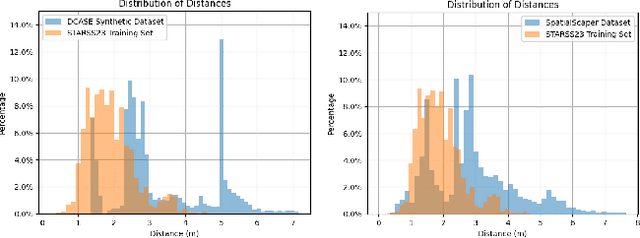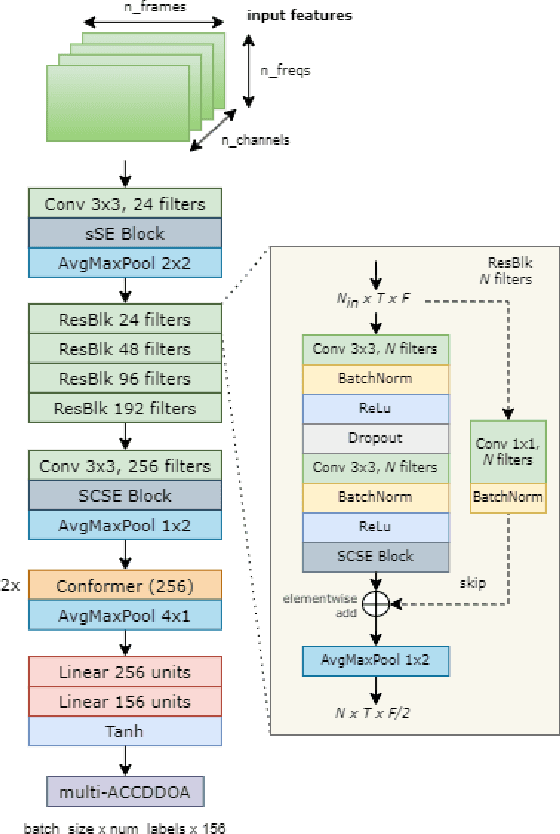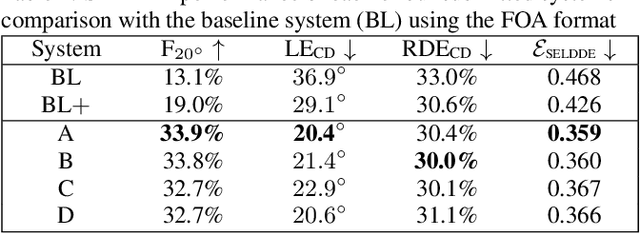Woon-Seng Gan
Preventing output saturation in active noise control: An output-constrained Kalman filter approach
Dec 25, 2024Abstract:The Kalman filter (KF)-based active noise control (ANC) system demonstrates superior tracking and faster convergence compared to the least mean square (LMS) method, particularly in dynamic noise cancellation scenarios. However, in environments with extremely high noise levels, the power of the control signal can exceed the system's rated output power due to hardware limitations, leading to output saturation and subsequent non-linearity. To mitigate this issue, a modified KF with an output constraint is proposed. In this approach, the disturbance treated as an measurement is re-scaled by a constraint factor, which is determined by the system's rated power, the secondary path gain, and the disturbance power. As a result, the output power of the system, i.e. the control signal, is indirectly constrained within the maximum output of the system, ensuring stability. Simulation results indicate that the proposed algorithm not only achieves rapid suppression of dynamic noise but also effectively prevents non-linearity due to output saturation, highlighting its practical significance.
AudioSetCaps: An Enriched Audio-Caption Dataset using Automated Generation Pipeline with Large Audio and Language Models
Nov 28, 2024Abstract:With the emergence of audio-language models, constructing large-scale paired audio-language datasets has become essential yet challenging for model development, primarily due to the time-intensive and labour-heavy demands involved. While large language models (LLMs) have improved the efficiency of synthetic audio caption generation, current approaches struggle to effectively extract and incorporate detailed audio information. In this paper, we propose an automated pipeline that integrates audio-language models for fine-grained content extraction, LLMs for synthetic caption generation, and a contrastive language-audio pretraining (CLAP) model-based refinement process to improve the quality of captions. Specifically, we employ prompt chaining techniques in the content extraction stage to obtain accurate and fine-grained audio information, while we use the refinement process to mitigate potential hallucinations in the generated captions. Leveraging the AudioSet dataset and the proposed approach, we create AudioSetCaps, a dataset comprising 1.9 million audio-caption pairs, the largest audio-caption dataset at the time of writing. The models trained with AudioSetCaps achieve state-of-the-art performance on audio-text retrieval with R@1 scores of 46.3% for text-to-audio and 59.7% for audio-to-text retrieval and automated audio captioning with the CIDEr score of 84.8. As our approach has shown promising results with AudioSetCaps, we create another dataset containing 4.1 million synthetic audio-language pairs based on the Youtube-8M and VGGSound datasets. To facilitate research in audio-language learning, we have made our pipeline, datasets with 6 million audio-language pairs, and pre-trained models publicly available at https://github.com/JishengBai/AudioSetCaps.
Real-Time Sound Event Localization and Detection: Deployment Challenges on Edge Devices
Sep 18, 2024Abstract:Sound event localization and detection (SELD) is critical for various real-world applications, including smart monitoring and Internet of Things (IoT) systems. Although deep neural networks (DNNs) represent the state-of-the-art approach for SELD, their significant computational complexity and model sizes present challenges for deployment on resource-constrained edge devices, especially under real-time conditions. Despite the growing need for real-time SELD, research in this area remains limited. In this paper, we investigate the unique challenges of deploying SELD systems for real-world, real-time applications by performing extensive experiments on a commercially available Raspberry Pi 3 edge device. Our findings reveal two critical, often overlooked considerations: the high computational cost of feature extraction and the performance degradation associated with low-latency, real-time inference. This paper provides valuable insights and considerations for future work toward developing more efficient and robust real-time SELD systems
Data Efficient Acoustic Scene Classification using Teacher-Informed Confusing Class Instruction
Sep 18, 2024Abstract:In this technical report, we describe the SNTL-NTU team's submission for Task 1 Data-Efficient Low-Complexity Acoustic Scene Classification of the detection and classification of acoustic scenes and events (DCASE) 2024 challenge. Three systems are introduced to tackle training splits of different sizes. For small training splits, we explored reducing the complexity of the provided baseline model by reducing the number of base channels. We introduce data augmentation in the form of mixup to increase the diversity of training samples. For the larger training splits, we use FocusNet to provide confusing class information to an ensemble of multiple Patchout faSt Spectrogram Transformer (PaSST) models and baseline models trained on the original sampling rate of 44.1 kHz. We use Knowledge Distillation to distill the ensemble model to the baseline student model. Training the systems on the TAU Urban Acoustic Scene 2022 Mobile development dataset yielded the highest average testing accuracy of (62.21, 59.82, 56.81, 53.03, 47.97)% on split (100, 50, 25, 10, 5)% respectively over the three systems.
Transferable Selective Virtual Sensing Active Noise Control Technique Based on Metric Learning
Sep 09, 2024Abstract:Virtual sensing (VS) technology enables active noise control (ANC) systems to attenuate noise at virtual locations distant from the physical error microphones. Appropriate auxiliary filters (AF) can significantly enhance the effectiveness of VS approaches. The selection of appropriate AF for various types of noise can be automatically achieved using convolutional neural networks (CNNs). However, training the CNN model for different ANC systems is often labour-intensive and time-consuming. To tackle this problem, we propose a novel method, Transferable Selective VS, by integrating metric-learning technology into CNN-based VS approaches. The Transferable Selective VS method allows a pre-trained CNN to be applied directly to new ANC systems without requiring retraining, and it can handle unseen noise types. Numerical simulations demonstrate the effectiveness of the proposed method in attenuating sudden-varying broadband noises and real-world noises.
Extracting Urban Sound Information for Residential Areas in Smart Cities Using an End-to-End IoT System
Aug 11, 2024Abstract:With rapid urbanization comes the increase of community, construction, and transportation noise in residential areas. The conventional approach of solely relying on sound pressure level (SPL) information to decide on the noise environment and to plan out noise control and mitigation strategies is inadequate. This paper presents an end-to-end IoT system that extracts real-time urban sound metadata using edge devices, providing information on the sound type, location and duration, rate of occurrence, loudness, and azimuth of a dominant noise in nine residential areas. The collected metadata on environmental sound is transmitted to and aggregated in a cloud-based platform to produce detailed descriptive analytics and visualization. Our approach to integrating different building blocks, namely, hardware, software, cloud technologies, and signal processing algorithms to form our real-time IoT system is outlined. We demonstrate how some of the sound metadata extracted by our system are used to provide insights into the noise in residential areas. A scalable workflow to collect and prepare audio recordings from nine residential areas to construct our urban sound dataset for training and evaluating a location-agnostic model is discussed. Some practical challenges of managing and maintaining a sensor network deployed at numerous locations are also addressed.
* 13 pages, 15 figures, journal
Squeeze-and-Excite ResNet-Conformers for Sound Event Localization, Detection, and Distance Estimation for DCASE 2024 Challenge
Jul 12, 2024



Abstract:This technical report details our systems submitted for Task 3 of the DCASE 2024 Challenge: Audio and Audiovisual Sound Event Localization and Detection (SELD) with Source Distance Estimation (SDE). We address only the audio-only SELD with SDE (SELDDE) task in this report. We propose to improve the existing ResNet-Conformer architectures with Squeeze-and-Excitation blocks in order to introduce additional forms of channel- and spatial-wise attention. In order to improve SELD performance, we also utilize the Spatial Cue-Augmented Log-Spectrogram (SALSA) features over the commonly used log-mel spectra features for polyphonic SELD. We complement the existing Sony-TAu Realistic Spatial Soundscapes 2023 (STARSS23) dataset with the audio channel swapping technique and synthesize additional data using the SpatialScaper generator. We also perform distance scaling in order to prevent large distance errors from contributing more towards the loss function. Finally, we evaluate our approach on the evaluation subset of the STARSS23 dataset.
Automating Urban Soundscape Enhancements with AI: In-situ Assessment of Quality and Restorativeness in Traffic-Exposed Residential Areas
Jul 08, 2024



Abstract:Formalized in ISO 12913, the "soundscape" approach is a paradigmatic shift towards perception-based urban sound management, aiming to alleviate the substantial socioeconomic costs of noise pollution to advance the United Nations Sustainable Development Goals. Focusing on traffic-exposed outdoor residential sites, we implemented an automatic masker selection system (AMSS) utilizing natural sounds to mask (or augment) traffic soundscapes. We employed a pre-trained AI model to automatically select the optimal masker and adjust its playback level, adapting to changes over time in the ambient environment to maximize "Pleasantness", a perceptual dimension of soundscape quality in ISO 12913. Our validation study involving ($N=68$) residents revealed a significant 14.6 % enhancement in "Pleasantness" after intervention, correlating with increased restorativeness and positive affect. Perceptual enhancements at the traffic-exposed site matched those at a quieter control site with 6 dB(A) lower $L_\text{A,eq}$ and road traffic noise dominance, affirming the efficacy of AMSS as a soundscape intervention, while streamlining the labour-intensive assessment of "Pleasantness" with probabilistic AI prediction.
Computation-efficient Virtual Sensing Approach with Multichannel Adjoint Least Mean Square Algorithm
May 23, 2024Abstract:Multichannel active noise control (ANC) systems are designed to create a large zone of quietness (ZoQ) around the error microphones, however, the placement of these microphones often presents challenges due to physical limitations. Virtual sensing technique that effectively suppresses the noise far from the physical error microphones is one of the most promising solutions. Nevertheless, the conventional multichannel virtual sensing ANC (MVANC) system based on the multichannel filtered reference least mean square (MCFxLMS) algorithm often suffers from high computational complexity. This paper proposes a feedforward MVANC system that incorporates the multichannel adjoint least mean square (MCALMS) algorithm to overcome these limitations effectively. Computational analysis demonstrates the improvement of computational efficiency and numerical simulations exhibit comparable noise reduction performance at virtual locations compared to the conventional MCFxLMS algorithm. Additionally, the effects of varied tuning noises on system performance are also investigated, providing insightful findings on optimizing MVANC systems.
A Survey of Integrating Wireless Technology into Active Noise Control
May 21, 2024



Abstract:Active Noise Control (ANC) is a widely adopted technology for reducing environmental noise across various scenarios. This paper focuses on enhancing noise reduction performance, particularly through the refinement of signal quality fed into ANC systems. We discuss the main wireless technique integrated into the ANC system, equipped with some innovative algorithms, in diverse environments. Instead of using microphone arrays, which increase the computation complexity of the ANC system, to isolate multiple noise sources to improve noise reduction performance, the application of the wireless technique avoids extra computation demand. Wireless transmissions of reference, error, and control signals are also applied to improve the convergence performance of the ANC system. Furthermore, this paper lists some wireless ANC applications, such as earbuds, headphones, windows, and headrests, underscoring their adaptability and efficiency in various settings.
 Add to Chrome
Add to Chrome Add to Firefox
Add to Firefox Add to Edge
Add to Edge